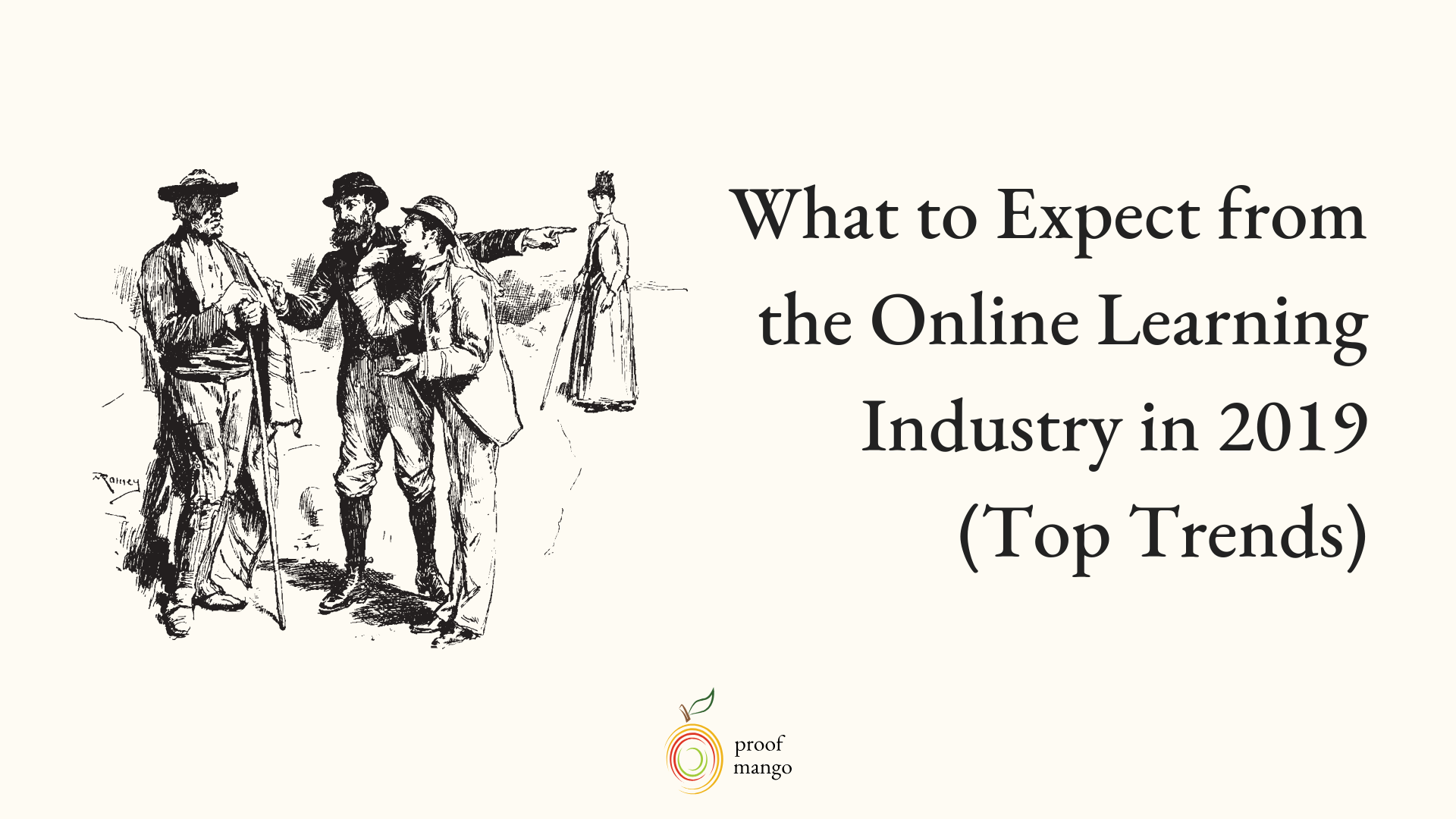The online learning industry is evolving in 2019. Students are expecting more. This year, it will be less about how much money you can make with your course, and more about the quality you're delivering to students who want to watch your course on their time, their way. 
For the online learning industry, 2019 will be the year of the student.
If you haven't heard the whispers yet about quality courses trumping all others, it's about to become known.
Students are demanding far more than just PDFs and YouTube videos in a course.
They want your attention. They want community. They want learning paths that fit them like a glove.
To keep pace with the evolving industry of online learning, check out five of the top trends we noticed that are taking shape this year.
#1 Adaptive learning
Adaptive learning is a method of online teaching that gives students a personalized learning path based on course analytics, assessment data, feedback from students, and course algorithms.
Creating course content that is adapted and customized for the user is expected to increase this year in the hopes of encouraging higher completion rates.
If learning paths are specific to he learner's experience and skill, they'll be able to pick a path that gives them exactly what they need.
And when students have what they need to succeed, they're more likely to share the transformation your course gave them, and write killer course reviews down the line.
Because no two people learn alike.
By customizing course content for different users and learning styles, there's a high likelihood that students will start finishing what they start when they buy a course from you.
If you're looking to add adaptive learning to your course this year, here's a short list of platforms that offer it:
#2 Microlearning
Microlearning is nothing new in online learning, but it's not going anywhere in 2019.
Like a bite-sized learning snack, microlearning allows students to consume highly-focused, bite-sized information on any device, between 3-6 minutes in video length. It has perfectly evolved to suit today's busy learner.
The great thing about microlearning is that it allows students to fill specific gaps in their knowledge instantly. It's like being hungry for a great Netflix watch and finding it right when you log in — it satisfies the need for students to learn exactly what they need to move forward quickly.
This relates to the overall theme I mentioned in the beginning of this post, about online learning in 2019 being all about the student.
Microlearning is an emerging trend that gives students the opportunity to learn what they want, when they want, and how they want.
It'll be especially huge for corporate learners, since research from UC Irvine found that employees have super short attention spans. They can only focus on one task for about 11 minutes before being interrupted by a ping, text, or email.
If you expect your learners to consume your training in today's world of 8-second attention spans, microlearning will be hard to ignore.
There are some great resources out there on incorporating microlearning into your training. I've listed a few to get your feet wet below:
9 Tips to Create Engaging Microlearning Content
Everything You Need to Know About Microlearning (Guide/Email Opt-in – I downloaded it and it's comprehensive)
4 Microlearning Trends to Watch in 2019
#3 Video learning
Video learning isn't going anywhere in 2019.
In 2019, just as in 2018, people want more than text-based content.
With mobile learning on the rise, video is rising right along with it. Online learners want accessible training that's easy to consume, and video is just that.
A report from Docebo notes that video delivers higher rates of engagement and improved learning experiences, which are two things you'll want to consider for your online course going into this year.
And don't worry if video scares you – you're your own worst critic in the end. You don't have to have the most professional quality in your videos. As long as the videos show your genuine self and get the point across, you'll be fine.
In fact, research shows that students prefer videos that mimic YouTube style videos over TV quality videos. The quality of the video doesn't matter as much as long as you are enthusiastic and genuine, and sharing knowledge that helps your students actually take action and transform into who they want to be.
#4 Game-based learning
Game-based learning, or gamification, isn’t anything particularly new in online learning, but its capacity to engage learners isn't going unnoticed.
Gamification involves adding game mechanics to non-game contexts to motivate user participation.
For example, Starbucks. They give you stars every time you buy something in their stores. The more stars you accumulate, the closer you are to getting a free drink or food item.
Back in 2016, gamification in global education was forecasted to increase at a compound annual growth rate of 66.22% from 2016 – 2022.
As for 2019, gamification in online learning is emerging in exciting new ways. It's no longer about adding badges, points, and leaderboards to courses — it's getting a little more in depth than that. You may need to become more of a data scientist.
For example, an article from E-Learning Industry suggests that in 2019, the gamified experience in online learning will need to seriously “reflect and engage the target audience in order to help meet learning objectives.”
This means you'll need to understand your target audience through data-backed activities and analytics if you want to engage them in a way that will result in a behavior shift.
To quote an excerpt from the same article, “You can't change a behavior you can't measure.”
Incorporating gamification into your courses will now mean you need to get serious about what you're adding, and how it will get your students to experience your intended shift.
To learn more about adding gamification to online learning, check out these articles:
#5 Social learning
Social learning is the idea that we learn through other people by imitating them, observing them, or interacting with them.
Online courses can be an isolating experience, but with social learning, you're learning by interacting with your peers.
For example, some courses involve live coaching calls or webinars where students can interact with each other.
Social learning is trending upward in 2019 because it increases knowledge retention, which is getting to be a really big deal. Without creating an environment of connectedness among online learners, the learning experience won't be as engaging for the student.
In fact an article from Forbes last year said that successful online courses are built on community, where students can go beyond the course curriculum by interacting with one another.
It's also an opportunity to discuss the course in a non-formal learning setting, where students can collaborate and exchange ideas about what they're learning. Plus, the 70-20-10 learning framework suggests that 70% of learning happens through experience, 20% happens through peer-to-peer interaction, and 10% in formal, instructor-led classrooms.
“In traditional learning environments, most people recall only 10% of the information taught within 72 hours,” says Matt Powell on the Docebo blog. “Consider the impact that lack of knowledge retention could have on your organization.”
This year, you can implement social learning in your courses by:
- Creating discussion forums and/or Facebook groups for students to ask questions and collaborate
- Incentivizing students to interact by offering rewards for online discussion participation
- Using live webinars or Zoom calls to foster connection and observation of other students (since social learning involves modeling peers by observing them)
Summary
2019 is an exciting time in the online learning industry. There will be a heavy focus on learners, but also on emerging technology that will make learning more student-focused and community driven.
To summarize, the trends we feel are going to be strong in 2019 are:
- Adaptive learning – No two people learn the same and with adaptive learning, we’re expecting a lot more courses to start implementing it. This will help both teachers and learners get the most out of courses, encouraging higher completion rates.
- Microlearning – Microlearning is an emerging trend that will give students the opportunity to learn what they want, when they want, and how they want.
- Video learning – Nothing new, but we’re expecting a large push in the coming year. Online learners want accessible training that's easy to consume, and video is the solution.
- Game-based learning – Gamification motivates user participation, and nowhere is this more necessary than in the online classroom. Expect gamification to require more data-backed activities and analytics if you want to create a shift in your students.
- Social learning – Social learning offers more ways than ever for groups of people to collaborate and learn together. Look out for forums, Facebook groups, and live webcasts.
Now tell me this: what trends do you see as important to your online course business? Are you already implementing some of these trends? Let me know in the comments!
Until next time friends,
Monique





